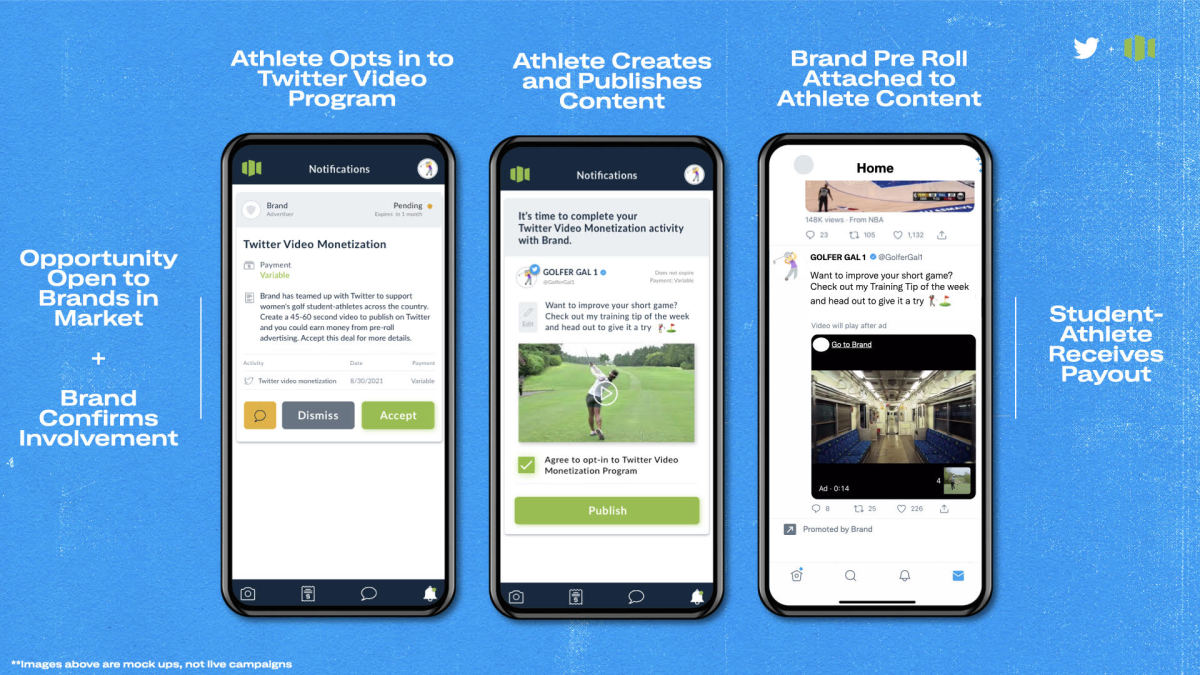Twitter, Opendorse Partnership to Facilitate Video Sponsorships for College Athletes

For a long time, sponsored content on Twitter has often been reserved for some of the most powerful sports leagues and media companies in America.
Promoted video tweets from the likes of the NFL, PGA Tour and ESPN conveniently find their way onto a user’s timeline featuring pre-roll advertisements that Twitterers must watch to access the content. The revenue from those ads is then shared by both Twitter and the publishing companies in a money-making venture that produces upward of seven-figure campaigns.
Soon, college athletes can access this cash cow.
The social media company is partnering with Opendorse in a revenue-sharing venture to allow college athletes to monetize their content through Twitter’s video sponsorship platform Amplify. The companies announced the deal Thursday in an exclusive with Sports Illustrated.

Twitter becomes the first social media platform to launch plans related to athlete compensation, often referred to as name, image and likeness (NIL). On July 1, for the first time ever, NCAA athletes will be able to use their name, image and likeness to profit from endorsement and commercial deals—the successful end of a sweeping, nationwide effort to grant college stars the same rights as any other college student.
The deal between Twitter and Opendorse, a sports content publisher, will allow brands, such as Nike, Adidas and Coke, to pitch ideas and compensate athletes for participating in Twitter video campaigns built around a selected theme and geared toward fans of a specific audience.
For instance, Nike may propose a $100,000 ad campaign about workout training tips from Division I basketball players. Using Opendorse Deals—the company’s compliant marketplace—college basketball players who choose to opt into the campaign would create short video clips about their training, post them on their timeline and then, depending on the clip’s viewership, would each receive a cut of the ad budget, sharing the money with other athletes, Opendorse and Twitter.
Athletes will retain the majority of generated revenue, officials from Twitter and Opendorse say.
“Student athletes have been marginalized,” says David Herman, Twitter’s senior sports partner manager. “We want them to see the benefits of their NIL. The real winners are the student athletes. They will be paid based on what their videos are actually earning.”
Herman describes this as Twitter’s completion of a full landscape of work in college sports. In the past, the company’s college sports sponsorship ad content could only be found with media partners like ESPN, Fox Sports and Big Ten Network. Now, the platform is adding actual athletes, who the NCAA had previously prohibited from entering into such deals.
That all changes in a month’s time. The NCAA plans to lift longtime amateurism policies in a move triggered by state legislatures that have created laws to grant their athletes NIL rights. At least 17 states have passed NIL laws, five of those that take effect on July 1.
Opendorse’s inclusion in the partnership allows brands to easily pitch the platform’s more than 40,000 athlete users while also ensuring that athletes remain within guardrails to maintain their eligibility.
Predicting how much revenue an athlete will generate from an ad campaign is difficult, says Blake Lawrence, the co-founder and CEO of Opendorse. But he believes that advertisers see the opportunity to connect with college athletes as a “blue ocean.” He says athletes have a 20 times higher engagement audience than their own teams.
“This is a new world,” Lawrence says.
According to Twitter, it has 187 million monetizable advertising daily active users, a number that is expected to increase by 3% this year. Advertisers spent $808 million on Twitter in the third quarter of 2020.
Herman hopes advertisers choose to target athletes beyond the top football and men’s basketball stars. In fact, Lawrence expects that brands will want to be the first to offer opportunities en masse to Olympic sport and women athletes.
“The first five years of NIL and specifically this with Twitter is going to be tied to being the first advertiser to do something,” Lawrence says. “It will matter to be the first advertiser to directly support women soccer players, for example.”
If this sounds like group licensing, it’s not, says Herman. Group licensing, prohibited by the NCAA and often linked to video game and jersey sales, provides one-stop shopping for companies seeking multiplayer product or promotional lines.
“There is some mentality similar to group licensing,” Herman says, “but we think how we are positioning it and how athletes are opting in, it is still very much an individualized acceptance.”
Athletes are paid by how many “charges” their video produces, Herman says. A charge happens when a Twitter user clicks the video clip and watches the 10–30 second ad before the content rolls. The sponsored videos will not only be available to an athlete’s followers but will be promoted across Twitter channels, expanding an athlete’s reach and introducing them to new users.
In simple terms, Lawrence says, the larger an athlete’s following and the more quality content they produce, the more likely they are to earn more revenue. The number of athletes participating in a specific deal also impacts an athlete’s revenue cut.
For instance, if Nike spent $100,000 in an ad campaign that five athletes opted into, those athletes, Opendorse and Twitter would split the $100,000 in the revenue-sharing model. Specific percentages are not being disclosed. The revenue of a deal will always add up to the contractual amount that the advertiser agreed to spend. Once the ad campaign ends, athletes receive the funds through Opendorse Deals, at which they can withdraw them at any time.
Opendorse is in discussion about similar deals with other social media platforms, Lawrence says, but many of them are waiting for legislation to be finalized before agreeing to terms.
More College Sports Coverage:
• Congress Making Critical Progress on NIL, Athletes' Rights
• Legislation Seeks Collective Bargaining Rights for College Athletes
• Hilinski Family Persists in Mental Health Advocacy
